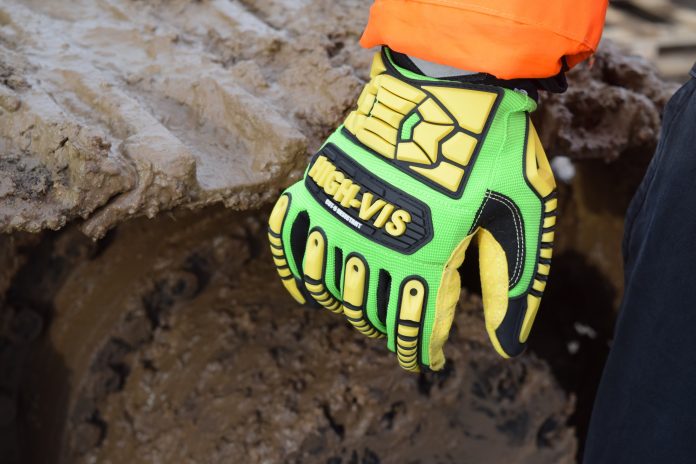![]()
Fluid injection injuries can be extremely harmful with all cases requiring emergency surgery. JuvaPRo have anew range of HI intensity gloves which covers every risk associated with Rigging, Oil and Gas Drilling, Extraction and Refining, Fracking, Tool Pushing, Mining, Demolition, and Heavy Construction
A typical example of how and when workers are at risk of receiving a fluid injection injury is through hydraulic hose failures but also there is also a huge risk from abrasives disks and hot works. The force of fluid forced through a pinhole break in a hydraulic hose can be in excess of 250 metres per second (600 ft/s). Fluid, released in a fine jet at this force will penetrate through protective clothing, including protective gloves.
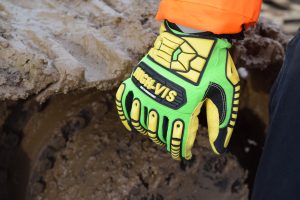
Hydraulic injection can be defined as the puncturing of the epidermis by a jet of a fluid under pressure. Hydraulic injection injury is the term used to describe an injury sustained by an individual following an injection of fluid, usually while operating or inspecting pressurised hydraulic equipment. While reported instances of injury through hydraulic injection are comparatively uncommon in the UK, the risk of injury through hydraulic injection is common to all hydraulic equipment irrespective of the system volume and can occur at relatively low pressures.
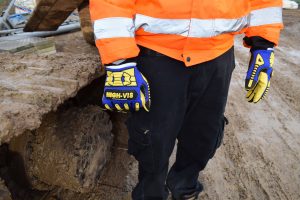
The new SDX2 Gloves have some great new features:
- New design on the finger tips with shorter rubber tube to give fingers maximum comfort and dexterity.
- Added a reflective tape across the wrist to enhance the hand visibility.
- We are now using dual Kevlar thread stitching on palm for maximum durability and ensuring long lasting gloves.
- The whole palm is covered in one piece of synthetic leather to increase the cut resistance level from level 1 to level 2 in EN388 standard.
- Cuff puller – get your glove in the proper position faster (extended neoprene cuff).
Reflective tape on the wrist Cuff – snug fit, easy to remove, breathable - Gel padded palm gloves (SDXO2) are excellent for shock absorption and heat resistance.
- SDXC5, SDXW and SDX2 gloves have PVC dots on the palm fur supergrip.
- HRC5 and HRIG gloves have a durable rope channel reinforcement that is 8 times more durable than normal synthetic leather.
MAXIMISE GLOVE DURABILITY & REDUCE PPE COST
Abrasion resistance ratings are often used to evaluate the durability of a glove – that is, how long a glove will last in the field, when used for a variety of tasks. This is a key metric, because glove durability directly affects the overall cost of hand protection programs. The maths is simple and effective: a £40 pair of gloves that lasts 6 months is three times as cost effective as a £20 pair of gloves that lasts one month.
This is a more complex issue than one might think. In today’s era of performance work gloves, safety professionals are under increasing pressure to provide high dexterity gloves to employees, but at a low cost that satisfies purchasing constraints. While there is a temptation to move downstream in price, the reality is that a glove designed to maximise durability might cost twice as much as what you are purchasing today, but could reduce your overall hand safety costs by more than 50%. This glove could also protect and perform significantly better for your employee’s particular tasks.
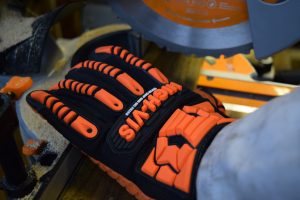
To evaluate durability, many professionals rely on abrasion resistance ratings. Several tests exist that evaluate abrasion resistance the most common test is outlined below:
• EN 388-2003 is the European standard that has been adopted by many countries worldwide. Gloves are assigned a rating of 0-5 based on results from the ISO 12947-1 abrasion testing standard. This test utilises a Martindale abrasion machine, and the testing endpoint is when there is a hole in the palm fabric. The standard states that only fabrics that maintain complete palm, finger and thumb coverage are tested. If there are multiple fabrics, each one is tested separately and results added together. If a fabric only covers a portion of the palm it is removed and not included in test results. Thus, the weakest point defines the test results.
• Most performance work gloves that are promoted as ‘high abrasion resistance’ have reinforcements in several locations – fingers, palm, saddle and thumb. This will result in higher abrasion resistance in the reinforced areas, but keep in mind that reinforcement layers typically have exposed edges, and edges often fail before the fabric fails. Reinforcement layers also have exposed stitching, which will most likely fail before the reinforcement fabric fails, especially if the stitching ‘rides high’ on the surface of the fabric. With the High-Vis gloves range the stitching is flush on the surface and includes a one-piece palm fabric significantly reducing the likelihood of fabric failures.
• Finger fourchettes (finger sidewalls) are not part of the standardised abrasion tests. Some gloves are constructed with low durability fourchette fabric, which will lead to early glove failure. The High-Vis range of gloves have patent-pending finger protection with 82% impact absorption that offers sidewall and complete fingertip protection.
Many early glove failures are due to seam and stitch failures. With the High-Vis range we use dual Kevlar thread for stitching ensuring maximum durability.
Our High-Vis gloves are produced to include a Teflon process making them water and oil resistant.
Opting to use our gloves will reduced hand safety cost per employee and increase employee safety at work.
Our gloves provide improved protection, comfort, dexterity and tactility to ensure maximum benefits to all employees assisting them in carrying out their work effectively, efficiently and crucially as safely as possible.
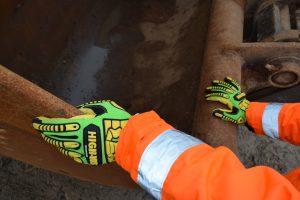
After all these improvement, the HIGH-VIS has more competitiveness than any other safety gloves in the market.
The injury’s which can be sustained are well documented and skin penetration can occur up to 100 mm away and at pressures as low as 100 psi. The injected fluid can lead to necrosis of the affected area, and compartment syndrome occurs, which always means surgery. Compartment syndrome, is caused when fluid under pressure, enters the hand causing nerve and tendon damage, which can lead to permanent damage. Blood poisoning and infection are almost certainly a side effect. Failure to act quickly may result in the need to amputate fingers and limbs. The risk of amputation significantly increases if the wound is not treated within a few hours.
These gloves are perfect for Hydraulic field technicians, Mobile hose replacement technicians, Plant maintenance fitters and anyone in a workshop or site environment



